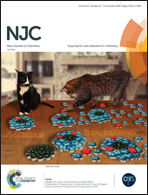Multifunctional BBF monolayer with high mechanical flexibility and strong SHG response†
Abstract
Multi-functional two-dimensional (2D) materials are being researched due to their attractive properties and novel applications in nano-electronic, nano-optoelectronic, topological insulator, and energy-storage devices. In the present contribution, with the aid of first-principles calculations, the mechanical and nonlinear optical properties of a newly designed Be2BO3F2 (BBF) monolayer were investigated. Our results illustrate that the BBF monolayer possesses unexpectedly higher flexibility than the typical and well-known flexible optoelectronic material MoS2 in terms of Young's modulus. Moreover, the BBF monolayer also exhibits a strong second harmonic generation (SHG) response of 5.65 × 104 pm2 V−1 which is 2.5 times that of a MoS2 monolayer. The honeycomb structure of the BBF monolayer appears to have a good mechanical stability, as revealed by the positive phonon modes and elastic constants. The highlighted electronic structure and properties, such as the large band gap (7.95 eV) and the large SHG response, make the BBF monolayer suitable for potential applications in flexible deep ultra-violet (DUV) nonlinear optical devices. We believe that the present research will provide useful guidance for the design of a new generation of nano-electronic devices.



 Please wait while we load your content...
Please wait while we load your content...